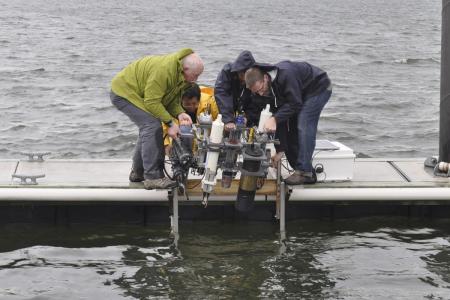A technology challenge to developing better and cheaper nutrient sensors made the White House's Top 100 list of projects making an impact in American science, technology, and innovation. Mario Tamburri, director of the Alliance for Coastal Technologies (ACT) at the UMCES' Chesapeake Biological Laboratory, has been a key member of the Challenging Nutrients Coalition, a national inter-agency initiative working to improve our ability to measure and understand nutrient pollution.
 Excessive nutrient levels in the Chesapeake Bay, and waters around the world, can fuel algal blooms that result in the summer’s ubiquitous ‘dead zones.’
Excessive nutrient levels in the Chesapeake Bay, and waters around the world, can fuel algal blooms that result in the summer’s ubiquitous ‘dead zones.’
“Nutrient pollution is the biggest, cross-cutting environmental problem, and our inability to make measurements of nutrients in the water—technology is currently too expensive and hard to use—is the biggest limitation to solving that problem,” said Tamburri. “Before we can solve the problem, we need the right tools.”
The Obama Administration led a Challenging Nutrients Coalition of Federal agencies, academia, and the private sector to bring open innovation and market stimulation approaches to develop better and cheaper nutrient sensors. In December 2014, the NOAA Administrator launched the Nutrient Sensor Challenge, and over 30 teams from around the world registered to participate.
Five finalist, representing four nitrate/nitrite and four phosphate next-generation sensors, were selected for final verification testing. In a series of laboratory tests and field trials this summer, ACT scientists will assess how well the sensors perform over a wide range of water conditions and nutrient levels, including the Chesapeake Bay, Maumee River Ohio and a coral reef in Hawaii. CBL is one of the field sites where the prototypes will run through their paces for three months off the lab's 750-foot research pier.
For more on the race to invent the technology needed to solve the nation’s nutrient pollution problem, read Better Tools for Cleaner Water in the June issue of Chesapeake Quarterly.

